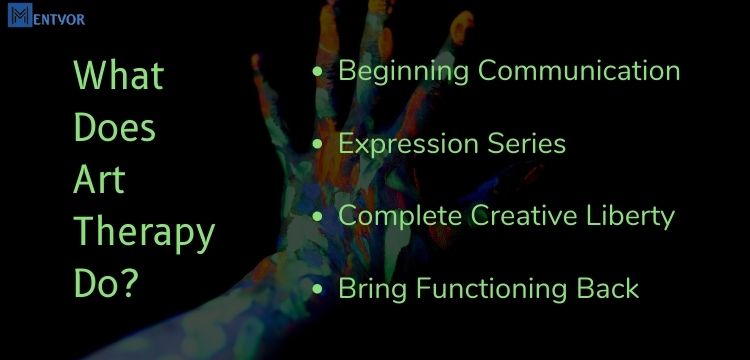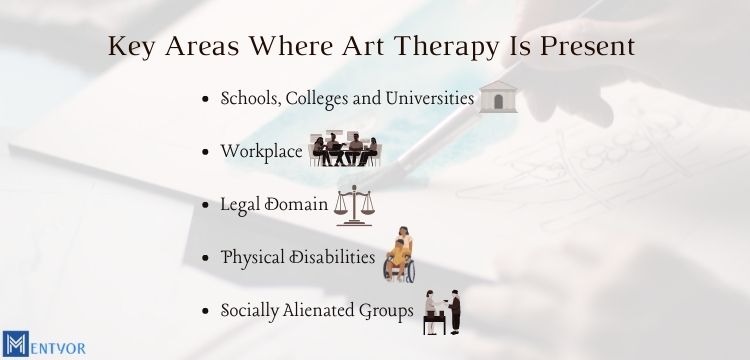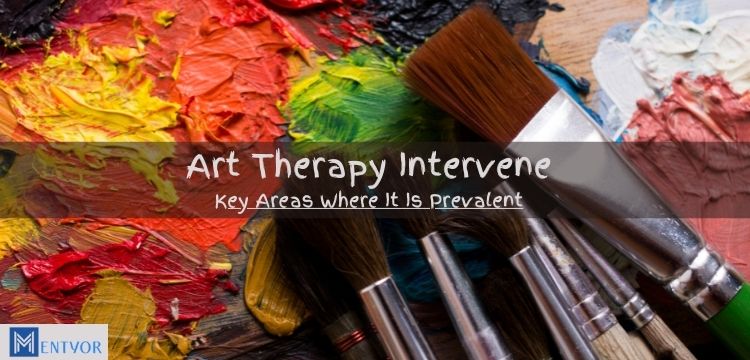Do you ever think of art as a rescue after it helps you forget a bad dream? Has it ever happened wherein music calmed down your jittery nerves. For all the times we have been stressed, art therapy has been an ideal option. For those who sought for any of the safest therapies, this could be their best way. Art therapy meaning evolved around the late twentieth century.
This happened when the psychologists and psychiatrists recognised the potential of artistic abilities. They determined how any form of artistic abilities can help reach the underlying thoughts of an individual. Since then, this concept of art therapy has continued to evolve. Today, it finds room in various settings and fields. Be it education or a workplace, art therapy functions differently yet efficiently.
To know what it is, is essential before we know the key areas it is working at. In this article, there will be a complete elucidation to what is the meaning of art therapy. Further, there will be an explanation to what exactly the the definition implies and does. Further, this article will completely elaborate on what are the areas and fields of art therapy being prevalent. Lastly, this article will summarise concepts of this, its application and the areas it is being used in.
Read and know more about Art Therapy: Healing Through Colors: Know What is Art Therapy
Art Therapy: What Is It?
In a rudimentary understanding, art therapy is the set of activities that allow any individual to freely express, heal and dispense their emotions. By doing so, the individual liberates from a certain incident and strives towards achieving a better goal. The American Psychological Association, defines the meaning as, “The process of making art is seen as healing”. It is “an experience that provides an opportunity to express oneself imaginatively, authentically, and spontaneously.” These activities will “lead to personal fulfilment, emotional reparation and transformation.” (1)

Art therapy is considered to be a kind of psychotherapy, which utilises the artistic potential to help understand an individual. It is not just confined to any one form of art such as painting. It spreads out to various artistic spaces such as music, drama, and more. The main meaning is to provide a channel for people to release what they have been feeling. It also includes expressing their unwanted emotions that have become potential speed breakers in their development.
Art therapy techniques make use of creative cognition of an individual to determine any symptoms of psychological illnesses. The types of colours used, or the drawing or the strokes, are all involved in determining a mental well being of the individual.
Further, the appreciation of the artworks will enhance the level of confidence, trust and induce willpower. This will also enhance social skills of the individuals and will promote a better adaptation to new changes. The entire meaning of art therapy revolves around providing a room for expression. There are certain instances which an individual fails to share, therefore, art can help him or her to do so.
Today, it has been in use to treat various types of mental adversities. Primarily, it is confined to treating the stress and anxiety levels of a person. However, now, this concept is being used in various other treatments such as Bulimia, Anorexia Nervosa, Post Traumatic Stress Disorder, and more.
Also, with these mental adversities, it is also confined to treating various emotional baggage, family hurdles and any kind of traumatic experiences. To avail to art therapy, one does not require to be of a certain age. You can try as a child, adult or during old age. The concept is not about you perfecting yourself. It aims at letting you open up and express. It streamlines the path for one to dispense their negativity and find their right or optimistic emotions.
The extent to which it can impact a person completely differentiates. The rate of its impact might be relatively slower or faster, as per the grasp of the individual. If a person is determined to look ahead to their past and find new energies, it can actually boost up that process. However, if a person is lacking the purpose or is dazed, it will work out slower for them. Further, the psychiatrist or the psychologist have to continue devising a suitable way so as to help the person progress ahead.
In a nutshell, the entire concept of art therapy can be summarised as using art to progress a person’s mental growth. Once the desired mental health is attained, it would contribute in developing the person’s physical well being. Further, it will help them in setting their new goals and looking forward towards achievement.
There are various tasks that determine what exactly it does. These tasks can be understood in an elaborated understanding in the next section.
What Does Art Therapy Do

There are various art therapy activities or tasks that determine it. These tasks highlight how it works as well as where exactly it can be utilised. The basic working of any therapy involves communication and expression. Along with these, there are various other associated tasks involved. These tasks and working of art therapy is explained in detail below.
Beginning Communication
The first and foremost working of any artistic activities in this is communication. The communication is in expanding format and continues to shift in various sub-settings of art therapy. First, the communication begins between the psychologist and the person. Further, in a collective session, the person’s communication might expand to some others, apart from the psychologists. In this process of various communication, there can be soliloquy that is more internalised and personal to the person. The person might communicate their feelings to themselves, through the form of art.
Expression Series
The next task that determines the functioning, is the expression series. Expression in this is of passive nature. The person might be involved in expression, but it does not have to be vocal all the time. The various forms of art therapy, such as singing, writing music, drama or painting are the means to know what the person is feeling. There are also times, when a person might only feel to express to a few people, including the psychologists. Another important factor required here is trust, so that the person feels comfortable in sharing their exact feelings.
Complete Creative Liberty
The meaning works when there is no certain creative pressure on the person. Creative pressure resembles artistic function. If we understand what the exact goal is, it is to provide a channel for expression. With liberal restrictions, the expression of the person would be more honest in letting know what they have been feeling. The time we impose any kind of creative barricade, the connection to the person’s subconscious mind is completely lost. Therefore, the tasks of it also involve making all the artistic restrictions flexible.
Bring Functioning Back
The tasks and activities of art therapy are directly aimed to bring back a person’s functioning. Functioning refers to a person’s optimistic thought process, effectively dealing with situations and streamlining future goals. This is important to activate a person’s way of life on a track that leads them to think and grow. Most of the people who seek this, might find their various senses lacking.
Therefore, this aims at letting the person grow their goals and look for a better future. This is also the factor that differentiates this from art classes. While art classes focus on artistic perfection, the goal of this is to let a person attain practical perfection.
These are the tasks and activities of art therapy that suggest how the entire concept works. Is works so as to provide a person with better channels of living life. It uses the potential of artistic power to leverage a better understanding towards life.
There are various domains and areas that have been induced with art therapy. These areas of therapy penetration can be understood in the next section.
Read to know more about Art Therapy Activities: Art Therapy Activities: What Are They And How They Heal
Key Areas Where Art Therapy Is Present

While it has the potential to be applied in a plethora of areas, it is highly prevalent in some of them. These areas, where this is common, are completely discussed below in detail.
Schools, Colleges and Universities
Art therapy has initially penetrated the academic domain. The earlier psychological analysis was conducted on students belonging to schools and colleges. It was used to study the repressed thoughts and internal feelings of the students, in academic terms. Therapy activities are essential to know the different mindset of different students, who are basically studying together. This helps the teachers or the mentors to devise a common pattern to assist all the students. It is also essential to understand whether a student is suffering through any mental dropout which is hard to express.
Workplace
Various workplace spaces have taken up in implementing this as an integral part of its training and functioning. In this sphere, it is essential to know whether the employees are efficient in taking up the workload. Further, it is essential to know if there is any sort of mental trauma or instance that is obstructing the workflow of the employees. Finally, these activities are needed in understanding how efficiently the employees can be socialised and frame a strategy to work collectively.
Legal Domain
Art therapy is also an essential part of the legal domain. In the legal domain, expression plays a very important role. A witness, or victim, in order to submit their testimony, has to express the incident accurately. In cases where the victim or the witness cannot express, psychological tools are used. Art therapy is one way to understand what the witness or victim wants to say. Further, art therapy is also essential to the legal domain, so as to maintain the confidentiality of the expression. Here, the prominent art form used is painting, sketching or writing.
Physical Disabilities
Art therapy is very essential to understand people with any physical or mental deformities. It is used on people with autism, physical handicapped and any other kind of deformities. For instance, a person with autism might express through drawing aspects of a particular incident. However, in this domain, the correct and appropriate application of art therapy is essential. The person with the disability has to be understood before any of the activities of art therapy is applied.
Socially Alienated Groups
Art therapy is much used in knowing and understanding the emotions of socially alienated groups. This group can be the castesised people, the LGBT community or any one that has no social recognition. Here, the work of art therapy is to understand the feelings of alienation, subjugation and mockery of the segregated community. Further, it is also essential to let these communities express themselves, and their repressed emotions towards the society.
These are the areas where art therapy has efficiently worked out. However, there are certain steps that are still essential to make the therapy activities successful. These factors differ based on each individual. The application of art therapy might be successful for a part of people, while some may find it completely void. This is why knowing the background of the mental episodes of a person is essential to apply art therapy successfully.
Read about Color Therapy: Color Therapy as Depression Therapy in Working Individuals | 4 Benefits
Parting Note
In this article, there is a complete explanation of what art therapy is. It is considered to be a kind of psychotherapy, which utilises the artistic potential to help understand an individual. It is not just confined to any one form of art such as painting. It spreads out to various artistic spaces such as music, drama, and more.
In this article, there is a broad explanation to what exactly it does. Art therapy essentially carries out various tasks, that emphasis on its basic meaning. These tasks include:
- Beginning Communication
- Expression Series
- Complete Creative Liberty
- Bring Functioning Back
This article also elucidates on the key areas where art therapy is applied. These areas of application for art therapy includes:
- Schools, Colleges and Universities
- Workplace
- Legal Domain
- Physical Disabilities
- Socially Alienated Groups
Commonly Asked FAQs
- What do you mean by art therapy?
Art therapy is considered to be a kind of psychotherapy, which utilises the artistic potential to help understand an individual. Art therapy is not just confined to any one form of art such as painting. It spreads out to various artistic spaces such as music, drama, and more.
- What are the art therapy tasks?
The art therapy tasks include:
- Beginning Communication
- Expression Series
- Complete Creative Liberty
- Bring Functioning Back
- What are the areas where art therapy works?
The areas of art therapy are:
- Schools, Colleges and Universities
- Workplace
- Legal Domain
- Physical Disabilities
- Socially Alienated Groups
- Is art therapy the same as art classes?
No. Art therapy is not the same as art classes. Art therapy is all about providing a medium of expression. Whereas, art classes are about perfecting the art skills.
- Is art therapy beneficial?
For art therapy to be beneficial, it is essential to understand the individual’s conditions, background and experiences. The rate of art therapy being beneficial completely differs. It might be high in some, while slow or near to inefficient if a person’s case is complex.


 WhatsApp
WhatsApp